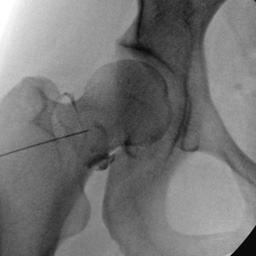• What are these injections and why are they performed?
• How should I prepare for the procedure?
• How is the procedure performed?
• What will I experience during the procedure?
• What are the benefits vs. risks?
• What are the limitations of these injections?
What are these injections and why are they performed?
Joint injections are performed for one (or more) of the following 4 reasons.
- Joint injections, much like epidural or nerve blocks for the spine, may be performed in order to relieve the pain of inflammation. A cortisone like drug and varying amounts of xylocaine (short acting pain relief) and marcaine (longer acting) are injected.
- Cartilage preserving substances such as Synvisc or Hyalgan are injected to “lubricate” an arthritic joint and relieve pain. Pain relief is never immediate but may take weeks to months to occur. Three injections are typically given, one week apart.

- It may be necessary to examine the finest details of a joint, such as the precise state of the lining cartilage or the condition of the labrum (a small structure at the edge of the shoulder and hip joint). The most accurate means of such assessment is to inject a substance known as gadolinium mixed with water. Gadolinium (a rare earth element for those of you who remember high school chemistry) is used to augment an MR procedure and is given by injection half way through the MR study.
- Artificial joints have a greater propensity to become infected than do native joints. In order to determine whether or not a painful artificial (or occasionally non artificial) joint is infected, an aspiration of the joint is performed. Aspiration refers to the removal of fluid in the joint with subsequent analysis by a laboratory. The fluid examination will help determine the type of antibiotic therapy to be administered if necessary.
How should I prepare for the procedure?
Cortisone type drugs act like as anti-inflammatory agents, reducing swelling and nerve irritation to allow the joint time to heal itself, thereby preventing further discomfort. These drugs are injected in such a manner that they coat the affected joint and its lining, the synovium. A patient may experience relief for a matter of days up to many months; however, the pain may eventually return, requiring either another injection or an alternative treatment.
The gadolinium enhanced MR has no positive or negative effect on the joint itself; it simply augments the MR examination.
Synvisc or Hyalgan coat the joint and appear to have a cartilage protective effect, reducing pain.
During simple aspiration, the joint fluid is removed but rarely is any substance injected and patient unlikely have any positive or negative effect.
How is the procedure performed?
This procedure is done on an outpatient basis.
An injection usually takes only 10 minutes to perform but the patient should expect to be in our facility for 30-45 minutes.
The doctor will identify where the injection should be given and will sterilize the skin with an antiseptic solution. He or she will then inject a local anesthetic to help numb the area before administering the injection.
Once the area is numb, the doctor will most likely use imaging guidance to help guide the needle to exactly the right position. When the needle is in place, a small amount of a contrast material (xray dye) will be injected so the doctor can ensure the distribution of the medication given. Then, your doctor will slowly inject the medication (cortisone, or gadolinium, or synvisc), or in the case of a suspected infection, will withdraw any fluid that is present.
When finished, you will be allowed to leave, or to finish the MR examination if necessary.
What will I experience during the procedure?
You may have no sensation whatsoever, however you may feel tingling or pressure when the injection is administered. When the injection is finished, however, any discomfort usually disappears.
In the case of a cortisone injection, there may not be any effect immediately-it is common for improvement in the pain to occur progressively over the first 48 hours. The effects may last for a matter of weeks, and often months. In the case of synvisc or Hyalgan, pain relief may take many weeks or even a few months.
What are the benefits vs. risks?
Benefits:
- Temporary or prolonged pain relief.
- Temporary or prolonged reduction of inflammation in the region of the joint causing pain.
- Better ability to function in daily life without the restrictions previously caused by pain.
Risks and Complications:
- The most common “complications” include rapid heart beat, sleeplessness and flushing of the skin, especially the face, for 24-48 hours after a cortisone injection. These side effects are uncomfortable but are not dangerous and don't require treatment.
- Temporary increase in pain, typically for 1-2 hours.
- The following are very very uncommon complications.
- Infection at the injection site.
- Bleeding if a blood vessel is inadvertently damaged.
- Injury to the nerves at the injection site.
What are the limitations of these injections?
Occasionally , the effects of such injections are temporary but each individual is different; many patients experience many months of improvement. If needed, the injection may be repeated after a number of weeks or months to receive maximum benefit from the medication. If the injections do not help alleviate your pain, your doctor will most likely recommend a different site of injection or possibly a different therapeutic approach.
© 2006 Mink Radiologic Imaging, Inc.